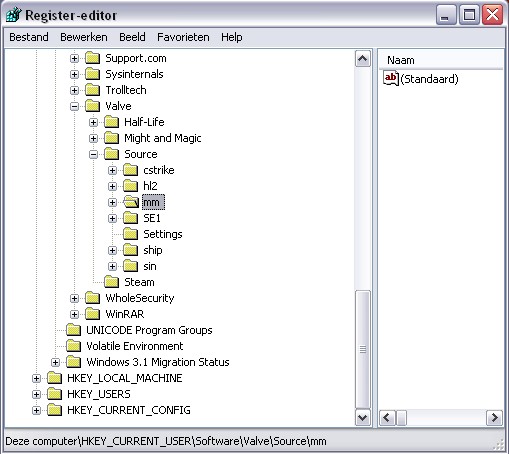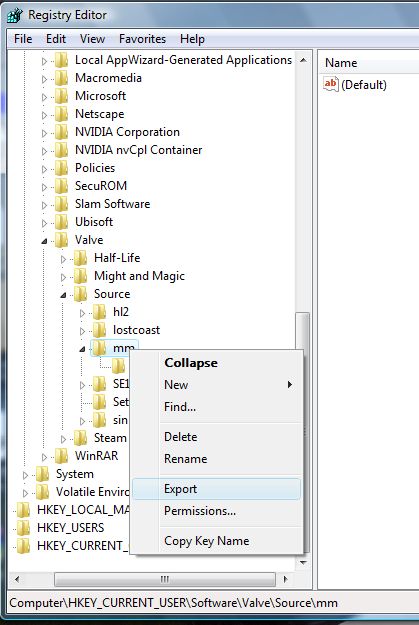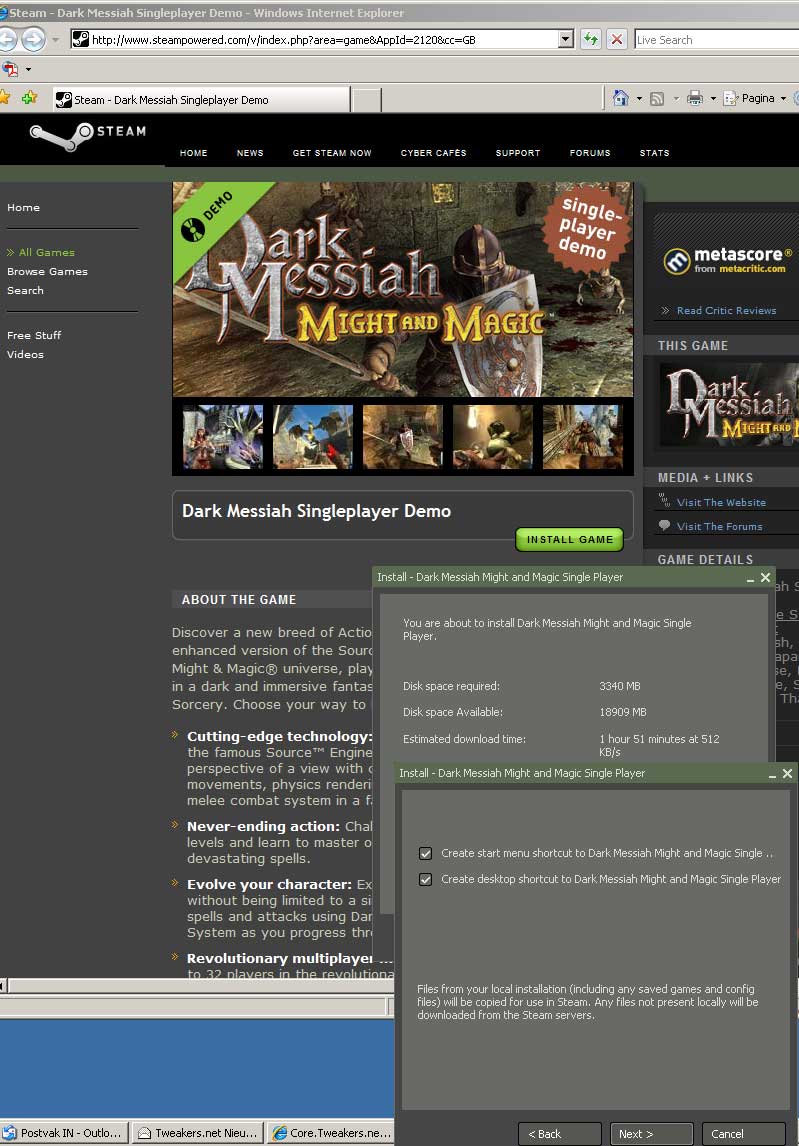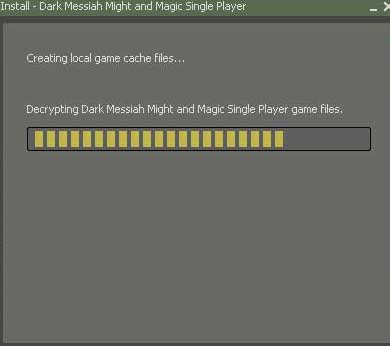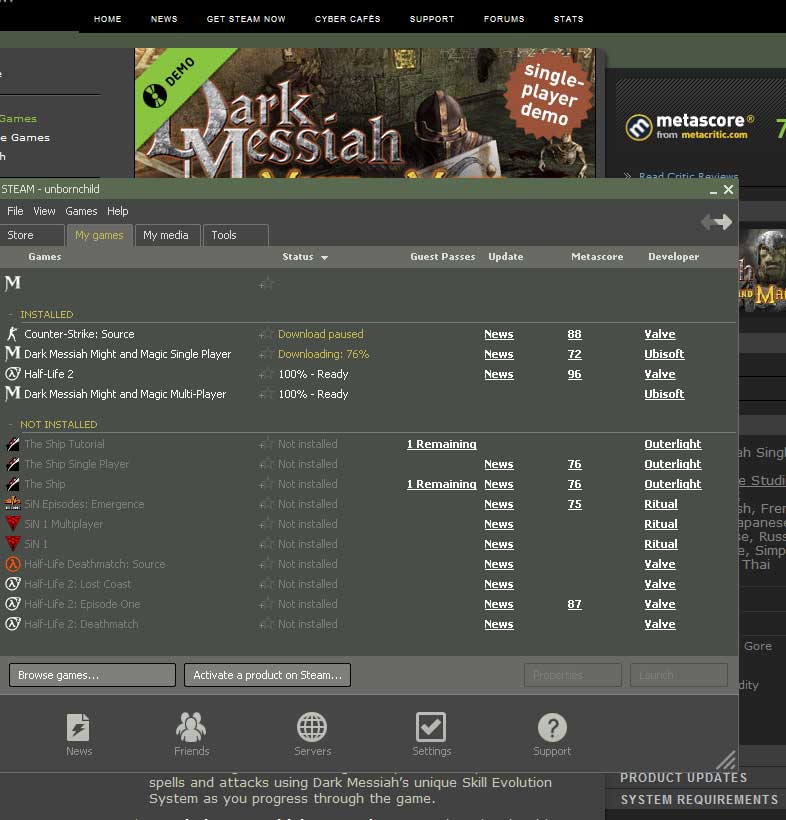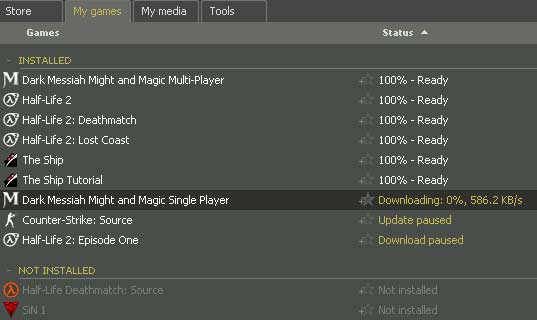- For anybody interested in how well (or not) their videocard is supposed to perform Dark Messiah,
Tom's Hardware guide.com has published their VGA Charts 2007.
Directly to their Dark Messiah Might and Magic benchmark chart:
https://www23.tomshardware.com/graphics_2007.html?modelx=33&model1=727&model2=1060&chart=283
Update: 5 July 2008, i see they have changed their charts page, re-using all values from their older tests, which in a mix makes a VERY inaccurate total-chart, utterly useless and misleading.
(One thing on Tom's site stands: their buying guide, it's usually straight to the point and accurate, refreshed every month).
Anyway, so this is their result.

Seeing their system setup, i wonder... with my Radeon X1900XT/512MB i get 10 fps better than their X1900XTX and 5 fps better result than their GF 8800GTX, at their same maxed out game settings... correction: even with 6xAA and 16xAF.
Can't be only because they used older drivers (which is unclear: Catalyst 7.1 on a Radeon HD3870 ???
But staggering is their poor HD3870 result: only 39 fps??? the card does 75 fps here....
My X1900XT results:
Intro Temple of Spider:

V-sync is off. All ingame settings maxed, CCC settings "application controlled" and defaults.
Logged fps each second:
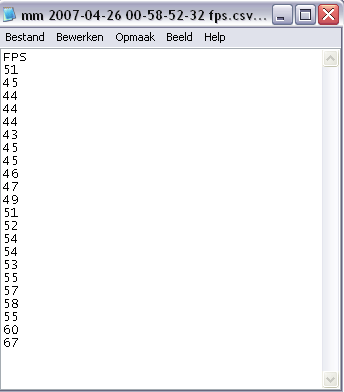
The part in the boat with Leanna up until talking to the victim:
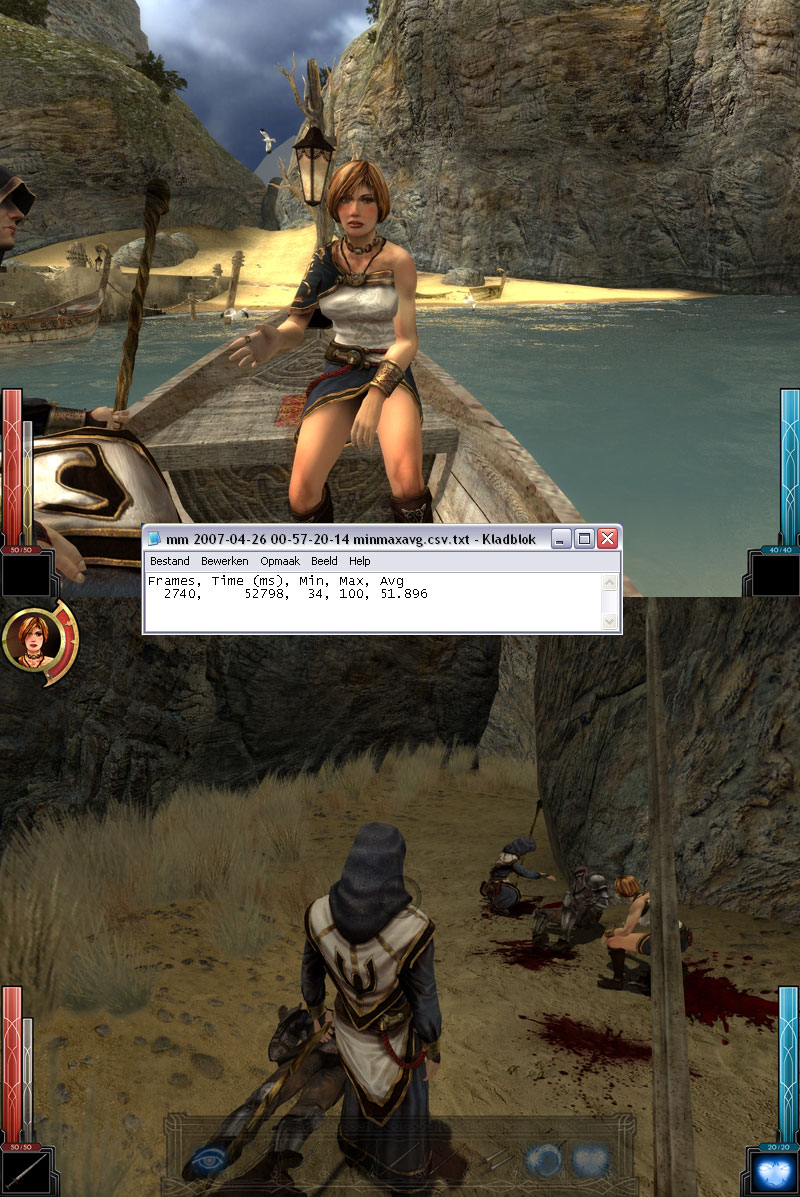
logged fps each second:
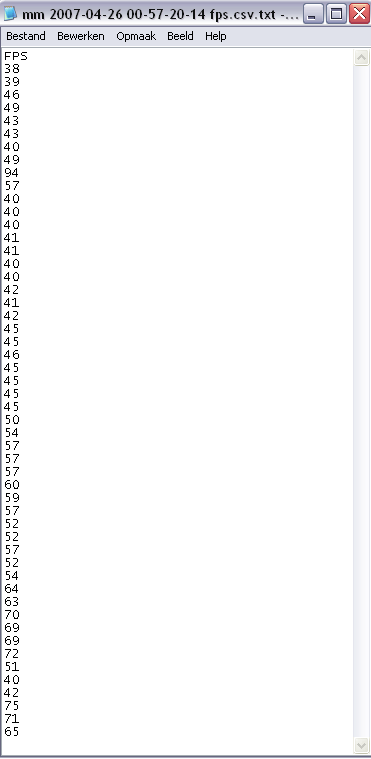
My games settings:
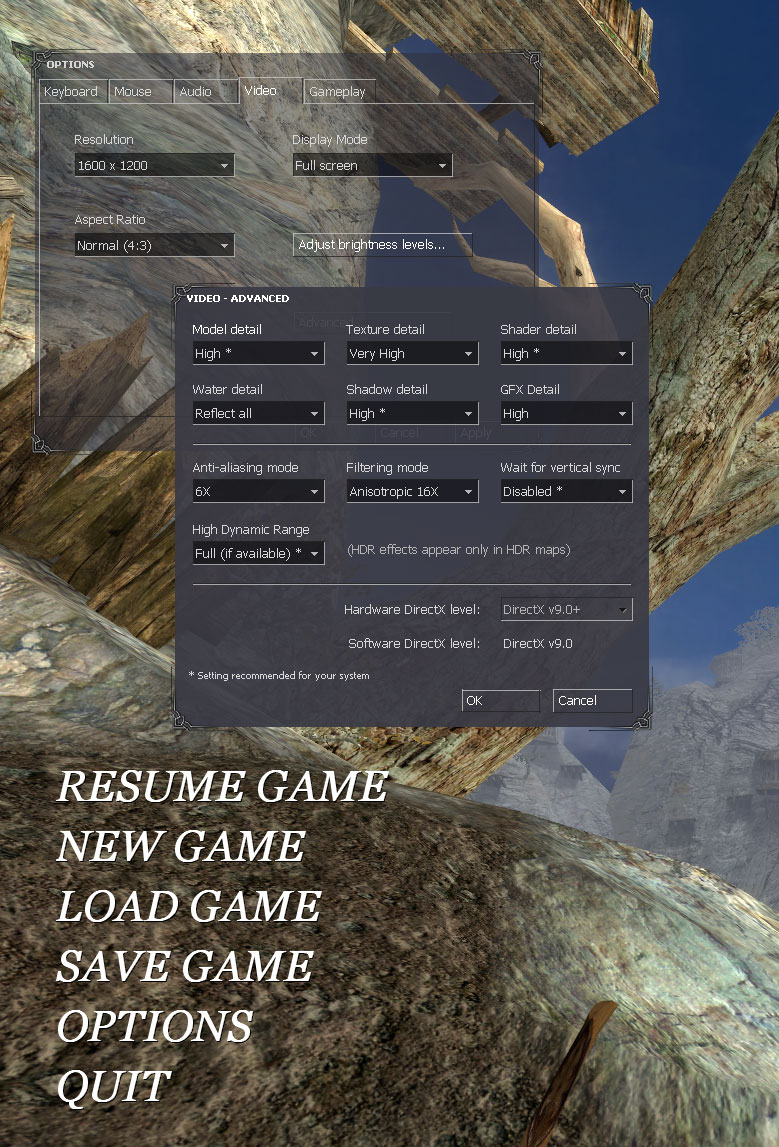
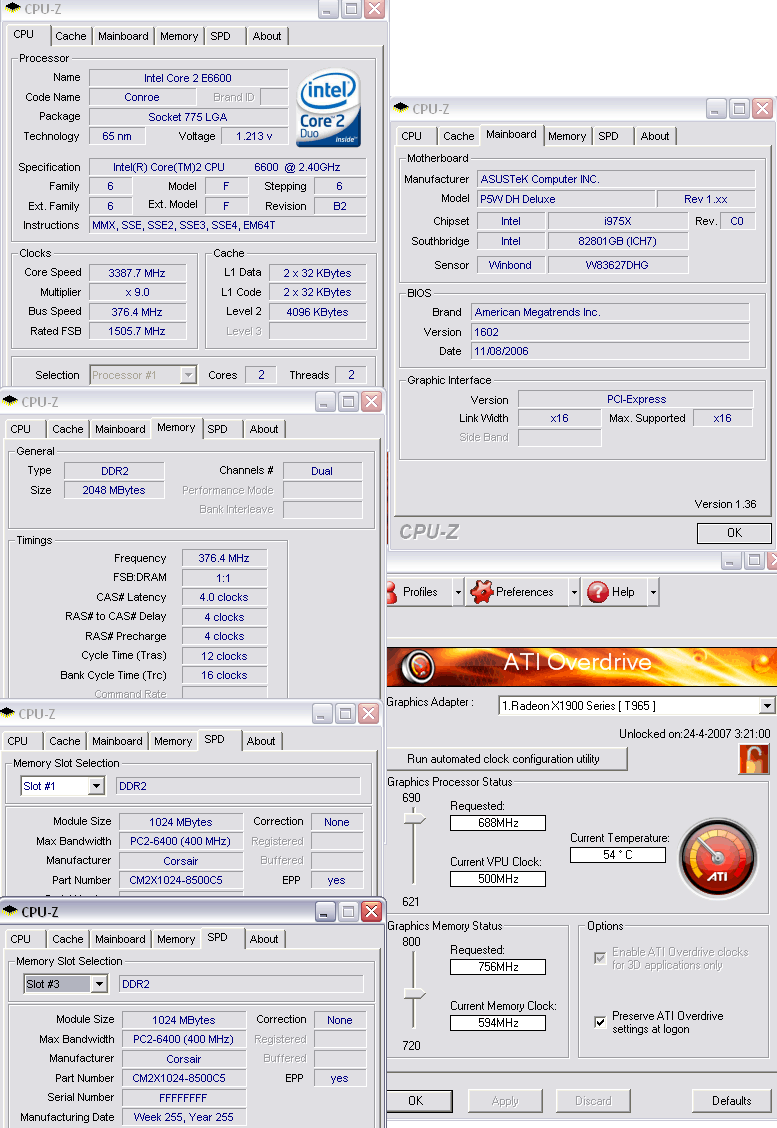
- Resuming, with X1900XT (512 MB):
Windows XP SP2 / DirectX9.0c february 2007
X1900XT (512 MB) / ATI Catalyst 7.4
Asus P5W-DH Deluxe (i975)
Intel E6600
Creative X-Fi Platinum / 8/17/2006
2x250 GB WDC WD2500KS
NEC DVD_RW ND-3540A
Eizo T965 1600x1200 / 85Hz
Logitech Z5500
Logitech wired Media keyboard
Logitech G7
V-sync is off. All settings maxed.- The part in the boat with Leanna up until talking to the victim:
Frames, Time (ms), Min, Max, Avg
2740, ....52798, ...34, ..100, 51.896
----------------------------------------- - Intro Temple of Spider:
Frames, Time (ms), Min, Max, Avg
1144, ....22349, ...42, ..71, 51.188
-----------------------------------------
- The part in the boat with Leanna up until talking to the victim:
- With Radeon HD3870 (512 MB) even better results.

V-sync is off. All ingame settings maxed, CCC settings "application controlled" and defaults.- The part in the boat with Leanna up until talking to the victim:
Frames, Time (ms), Min, Max, Avg
4008, ....52794, ...48, ..116, 75.918
----------------------------------------- - Intro Temple of Spider:
Frames, Time (ms), Min, Max, Avg
1534, ....21754, ...58, ..108, 70.516
-----------------------------------------------
System specifications:
CPU: Intel C2D E6750 @ 3.6 Ghz
CPU cooler: ZALMAN CPNS9700LED
Motherboard: ASUS Maximus Formula (bios 907)
System RAM: 4 GB Crucial Ballistix PC2-8500
Videocard: Sapphire HD3870 @ 855/1246 / Cat 8.2
Soundcard: Creative X-Fi Platinum
Harddiskdrives: WD 3200AAKS + WD 5000AAKS
PSU: Coolermaster Realpower M850
DVD-RW: Optiarc (NEC) DVD_RW AD-5170A
Monitor: Eizo T965 @ 1600x1200/85Hz
Coolermaster Stacker
Keyboard: Logitech Internet keyboard
Mouse: Logitech G9
OS: Windows XP Professional 32-bit
DirectX9.0c version: November 2007
Game: DVD version Dark Messiah of Might and Magic (patched 1.01 and 1.02)
- The part in the boat with Leanna up until talking to the victim:
- With Radeon HD4870 (512 MB) even better results.

This time on Windows Vista Ultimate SP1 64-bit.
V-sync is off. All ingame settings maxed, CCC settings "application controlled" and defaults.- The part in the boat with Leanna up until talking to the victim:
Frames, Time (ms), Min, Max, Avg
4557, ....50968, ...55, ..182, 89.409
----------------------------------------- - Intro Temple of Spider:
Frames, Time (ms), Min, Max, Avg
1653, ....22234, ...56, ..142, 74.346
-----------------------------------------------
CPU: Intel C2D E6750 @ 3.6 Ghz
CPU cooler: ZALMAN CPNS9700LED
Motherboard: ASUS Maximus Formula (bios 907)
System RAM: 8 GB Corsair Dominator PC2-8500 C5DF / 1081Mhz
Videocard: Sapphire HD4870 @ 790/1190 / Cat. 8.7
Soundcard: Creative X-Fi Platinum Fatal1ty Champion
Harddiskdrives: WD 5000AAKS + WD 5000AAKS
PSU: Coolermaster Realpower M850
DVD-RW: Optiarc (NEC) DVD_RW AD-5170A
Monitor: Eizo T965 @ 1600x1200/85Hz
Coolermaster Stacker
Keyboard: Logitech Internet keyboard
Mouse: Logitech G9
OS: Windows Vista Ultimate SP1 64-bit
DirectX9.0c version: July 2008
Game: DVD version Dark Messiah of Might and Magic (patched 1.01 and 1.02) - The part in the boat with Leanna up until talking to the victim:
- With Radeon HD4870X2 (1 GB effective) better once again:

Windows Vista Ultimate SP1 64-bit.
V-sync is off for this benchmark (i have it ON when gaming). For the rest, ingame settings maxed, CCC settings "application controlled" and defaults.- The part in the boat with Leanna up until talking to the victim:
Frames, Time (ms), Min, Max, Avg
5443, ....53447, ...64, ..197, 101.839
----------------------------------------- - Intro Temple of Spider:
Frames, Time (ms), Min, Max, Avg
1776, ....21268, ...61, ..169, 83.506
System specifications:
CPU: Intel C2D E8400 @ 3.825 Ghz
CPU cooler: ZALMAN CPNS9700LED
Motherboard: ASUS Maximus Formula (bios 1102)
System RAM: 8 GB Corsair Dominator PC2-8500 C5DF / 1081Mhz
Videocard: Sapphire HD4870X2 @ 750/900 / Catalyst 8.9
Soundcard: Creative X-Fi Platinum Fatal1ty Champion
Harddiskdrives: WD 6400AAKS + WD 5000AAKS
PSU: Coolermaster Realpower M850
DVD-RW: Optiarc (NEC) DVD_RW AD-5170A
Monitor: Eizo T965 @ 1600x1200/85Hz
Coolermaster Stacker
Logitech wired Media keyboard
Logitech G9
Logitech Z-5500
OS: Windows Vista Ultimate SP1 64-bit
DirectX9.0c version: Aug 2008
Game: DVD version Dark Messiah of Might and Magic (patched 1.01 and 1.02) - The part in the boat with Leanna up until talking to the victim:
^That ends the benchmarking at 1600x1200/85Hz on a CRT. Since April 2010 i'm using a 1920x1200/60Hz monitor (U2410).
- With a new system, i7 920 @ 3.8 Ghz and 2 x HD5870 1GB (crossfire).
_________________________________________________________________
System specifications:
i7 920 D0 @ 3.8 Ghz (19×200)
ZALMAN CPNS9900LED
Asus P6T Deluxe V2 (bios 610)
12 GB Corsair CMD12GX3M6A1600C8 DDR3 [triple channel]
Asus 2 × HD5870 crossfire @ 880/1260 - Catalyst 12.1 Preview
Creative X-Fi Titanium Fatality Pro [PCI-E]
WDC WD1002FAEX + WDC WD1002FAEX
Corsair HX 850W
Optiarc DVD RW AD-5240S
Dell U2410 @ 1920x1200/60Hz
Coolermaster Stacker
Steelseries G7
Logitech G9
Logitech Z-5500
OS: Windows 7 Ultimate 64-bit
DirectX9.0c version: Nov 2010
Game: DVD version Dark Messiah of Might and Magic (patched 1.01 and 1.02)
___________________________________________________________________
I'll start @1600x1200 with a single HD5870
V-sync is off. All ingame settings maxed, CCC settings "application controlled" and defaults.- The part in the boat with Leanna up until talking to the victim:
Frames, Time (ms), Min, Max, Avg
6875, .... 56676, ... 75, 219, 121.304
----------------------------------------- - Intro Temple of Spider:
Frames, Time (ms), Min, Max, Avg
2103, .... 21747, ... 72, 192, 96.703
With 2 x HD5870 crossfire the cpu-limit is reached (i7-920 @ 3.8 Ghz) resulting in a negative scaling:
@ 1600x1200/60Hz with 2 x HD5870 (crossfire)
(V-sync is off. All ingame settings maxed, CCC settings "application controlled" and defaults):- The part in the boat with Leanna up until talking to the victim:
Frames, Time (ms), Min, Max, Avg
6359, .... 57158, ... 62, 210, 111.253
----------------------------------------- - Intro Temple of Spider:
Frames, Time (ms), Min, Max, Avg
1999, .... 21964, ... 66, 184, 91.013
~~~~~~~~~~~~~~~~~~~~~~~~~~~~~~~~~~~~~~~~~~~~
Let's move to 1920 x 1200
~~~~~~~~~~~~~~~~~~~~~~~~~~~~~~~~~~~~~~~~~~~~
============================================
@ 1920x1200/60Hz with a single 5870
(V-sync is off. All ingame settings maxed, CCC settings "application controlled" and defaults):- The part in the boat with Leanna up until talking to the victim:
Frames, Time (ms), Min, Max, Avg
6534, .... 56145, ... 62, 211, 116.377
----------------------------------------- - Intro Temple of Spider:
Frames, Time (ms), Min, Max, Avg
1979, .... 21886, ... 71, 160, 90.423
============================================
Once again negative scaling (i7-920 @ 3,8 Ghz) when crossfire is enabled:
@ 1920x1200/60Hz with 2 x HD5870 (crossfire)
(V-sync is off. All ingame settings maxed, CCC settings "application controlled" and defaults):- The part in the boat with Leanna up until talking to the victim:
Frames, Time (ms), Min, Max, Avg
6342, .... 58360, ... 57, 215, 108.670
----------------------------------------- - Intro Temple of Spider:
Frames, Time (ms), Min, Max, Avg
1899, .... 21840, ... 59, 170, 86.951
- The part in the boat with Leanna up until talking to the victim:
- The same system but now the i7 920 CPU clocked @ 4,2 Ghz: (only for this test)
@ 1920x1200/60Hz with 2 x HD5870 (crossfire):- The part in the boat with Leanna up until talking to the victim:
Frames, Time (ms), Min, Max, Avg
7314, .... 58157, ... 67, 229, 125.763
----------------------------------------- - Intro Temple of Spider:
Frames, Time (ms), Min, Max, Avg
2221, .... 22012, ... 71, 199, 100.900
- The part in the boat with Leanna up until talking to the victim:
UPDATE
- On my new system with i7 2700K @ 4.8 Ghz and 7970 crossfire, even better results.
________________________________________________
i7 2700K @ 4.8 Ghz
Zalman CPNS9900-A LED
Asus Maximus IV Extreme-Z
16 GB Corsair Dominator GT CMT16GX3M4X2133C9
Sapphire HD7970 crossfire @ 1100/1575
Dell U3010 @ 2560 x 1600 [DVI-D]
Corsair AX 1200W
WDC WD1002FAEX + WDC WD1002FAEX
Creative X-Fi Titanium Fatality Pro [PCI-E]
Optiarc AD 5240S
Steelseries 7G
Logitech G9
Steelseries SX
Coolermaster Stacker STC T01
Logitech Z-5500
Sennheiser HD595
Windows 7 Ultimate x64 SP1
________________________________________________
@ 1920x1200/60Hz with 2 x 7970 (crossfire)
(V-sync is off. All ingame settings maxed, CCC settings "application controlled" and defaults):- The part in the boat with Leanna up until talking to the victim:
Frames, Time (ms), Min, Max, Avg
9903, .... 60201, ... 100, 280, 164.499
----------------------------------------- - Intro Temple of Spider:
Frames, Time (ms), Min, Max, Avg
2493, .... 20795, ... 92, 194, 119.885
~~~~~~~~~~~~~~~~~~~~~~~~~~~~~~~~~~~~~~~~~~~~
Let's move to 2560 x 1600
~~~~~~~~~~~~~~~~~~~~~~~~~~~~~~~~~~~~~~~~~~~~
============================================
(V-sync is off. All ingame settings maxed, CCC settings "application controlled" and defaults):- The part in the boat with Leanna up until talking to the victim:
Frames, Time (ms), Min, Max, Avg
9784, .... 61059, ... 94, 279, 160.238
----------------------------------------- - Intro Temple of Spider:
Frames, Time (ms), Min, Max, Avg
2494, .... 21076, ... 92, 198, 118.334
The performance is so good, ideal for using SSAA @ resolution 2560 x 1600, without vsync:

- The part in the boat with Leanna up until talking to the victim:
- The part in the boat with Leanna up until talking to the victim:
Frames, Time (ms), Min, Max, Avg
8240, .... 56067, ... 73, 239, 146.967
----------------------------------------- - Intro Temple of Spider:
Frames, Time (ms), Min, Max, Avg
1574, .... 21747, ... 58, 137, 72.378
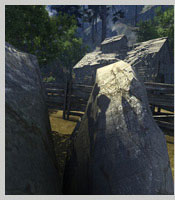 Call of Juarez using
Call of Juarez using 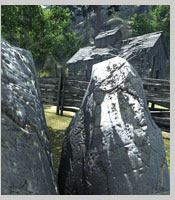 Call of Juarez using
Call of Juarez using 